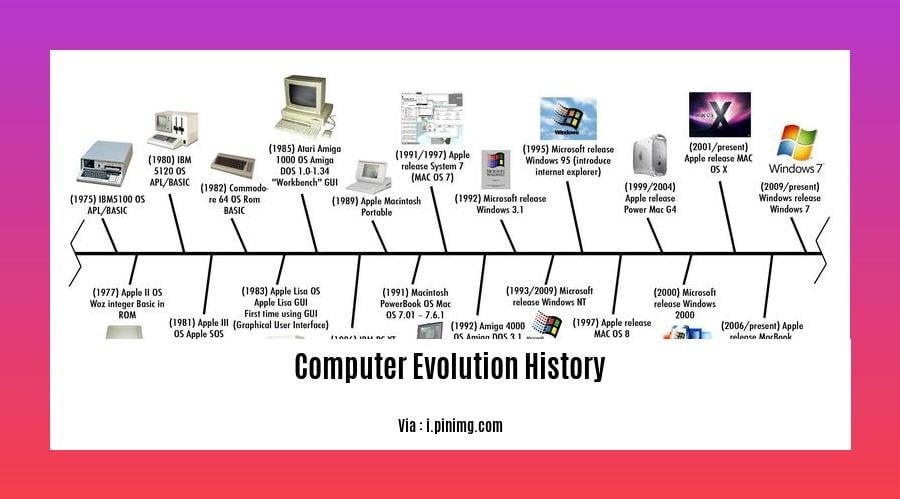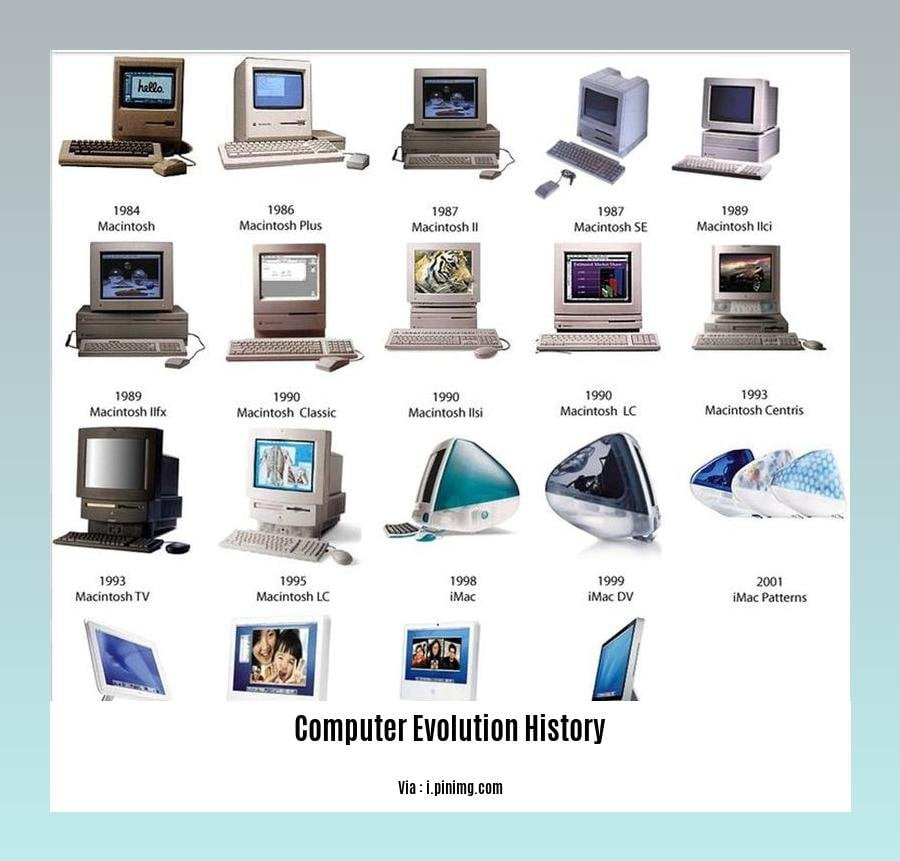Step into the captivating chronicle of computing history with “The Evolution of Computers: A Historical Journey Through Technological Milestones.” This illuminating article unveils the remarkable saga of technological breakthroughs that have forever transformed the world we live in. Join us as we embark on a journey through time, exploring the visionary minds and groundbreaking innovations that have shaped the computing landscape from its humble beginnings to the sophisticated devices we rely on today.
Key Takeaways:
- The abacus, invented in 2700 B.C., was the first digital computer.
- The Antikythera mechanism, created around 200 B.C., was the first analog computer.
- Charles Babbage’s Analytical Engine, designed in 1837, was a precursor to modern general-purpose computers.
- The transistor, invented in 1947, revolutionized computer technology.
- The integrated circuit (1958) and microprocessor (1971) made computers smaller, faster, and more affordable.
- Binary numbers, programmable looms, steam-driven computers, algorithms, and the Turing Machine played significant roles in computer history.
- In the 1960s, computers transitioned from professional to personal use.
- The Apple Macintosh (1980s) was a major milestone in the evolution of personal computers.
Computer Evolution: Tracing the Milestones of Technology

From the humble beginnings of the abacus to the ubiquitous smartphones in our pockets, computer evolution history is a fascinating journey of innovation and technological advancements. Join us as we delve into the key milestones that have shaped the computing landscape.
The Dawn of Digital Computing
The evolution of computers began with the invention of the abacus, the first digital computer, around 2700 B.C. It was followed by the Antikythera mechanism in 200 B.C., the first analog computer. These ancient devices laid the groundwork for the more complex machines that were to come.
Steam Power and Algorithms
In the 19th century, Charles Babbage’s Analytical Engine marked a significant milestone in computer evolution history. This steam-powered device could perform complex calculations and is widely regarded as the first general-purpose computer.
Around the same time, Ada Lovelace, considered the world’s first computer programmer, developed the first algorithm for the Analytical Engine, demonstrating the potential for computers to follow instructions and solve problems.
The Birth of Transistors and Integrated Circuits
The invention of the transistor in 1947 marked a pivotal moment in computer evolution history. Transistors replaced vacuum tubes, making computers smaller, faster, and more reliable. The subsequent development of integrated circuits (ICs) in 1958 paved the way for even smaller and more powerful computers.
Microprocessors and Personal Computers
The invention of the microprocessor in 1971 further miniaturized computers. This led to the development of personal computers (PCs), making computing accessible to individuals and businesses alike.
The Digital Revolution
The 1980s witnessed the introduction of the Apple Macintosh, which popularized the graphical user interface (GUI). This made computers more user-friendly and accessible to the general public. The subsequent development of the World Wide Web (WWW) in the 1990s transformed computers into gateways to a global network of information.
Modern Computing
Today, computers continue to evolve at an astonishing pace. From smartphones and tablets to cloud computing and artificial intelligence (AI), technology is transforming every aspect of our lives.
Here’s a timeline summarizing the key milestones in computer evolution history:
| Year | Milestone |
|---|---|
| 2700 B.C. | Abacus |
| 200 B.C. | Antikythera mechanism |
| 1837 | Analytical Engine |
| 1947 | Transistor |
| 1958 | Integrated circuit |
| 1971 | Microprocessor |
| 1984 | Apple Macintosh |
| 1990s | World Wide Web |
- Delve into the captivating history of computer to unravel the origins and evolution of this transformative technology.
- Relive key moments in the computing history milestones, from the invention of the ENIAC to the birth of the internet.
- Trace the advancement of computation through the history of computing devices, encompassing mainframes and personal computers to today’s ubiquitous smartphones.
Graphical User Interface (GUI): Transforming User Experience

Imagine trying to operate a computer without a graphical user interface (GUI). It would be like driving a car without a steering wheel or pedals – nearly impossible! GUIs have revolutionized the way we interact with computers, making them accessible and user-friendly.
In the early days of computing, interacting with a computer involved typing cryptic commands directly into a text-based interface. It was a cumbersome and error-prone process, accessible only to a select few. The introduction of GUIs changed all that.
GUIs use visual elements such as icons, menus, and buttons to represent actions and data. By clicking and dragging on these elements, users can navigate through files, launch applications, and perform various tasks without memorizing complex commands. This intuitive approach opened up the world of computing to a much broader audience.
One of the most significant milestones in GUI development was the release of the Apple Macintosh in 1984. The Macintosh popularized pixelated GUIs and made them mainstream. Other companies, such as Microsoft, quickly followed suit, and GUIs soon became the standard for personal computers.
Today, GUIs have evolved dramatically. High-definition displays, touch screens, and virtual reality headsets provide rich and immersive user experiences. GUIs have also become more intelligent, utilizing artificial intelligence to anticipate user needs and customize the experience.
Key Takeaways:
- GUIs revolutionized user interaction by providing visual cues and intuitive operations.
- The Macintosh and Windows systems played a major role in popularizing pixelated GUIs.
- GUIs have continued to evolve, leading to today’s high-definition interfaces.
- GUIs have transformed the way we interact with computers, smartphones, and other electronic devices.
Citation:
Era of the Internet: Global Connectivity
The evolution of the Internet has transformed the world into a globally connected village. This era of interconnectedness is the culmination of decades of scientific breakthroughs and international collaboration.
Key Moments in the Evolution of the Internet
- 1965: Donald Davies introduces the concept of packet switching, laying the groundwork for data transmission over networks.
- 1969: ARPA funds the development of ARPANET, the predecessor to the modern Internet.
- 1973-1989: The TCP/IP suite of protocols is developed, standardizing communication between networks.
- 1990-2003: The Internet expands globally, leading to the emergence of Web 1.0.
- 2004-Present: Web 2.0 revolutionizes the Internet with the rise of social media and interactive platforms.
China’s Internet Journey:
- 1994: China gains its first global Internet connection.
- However, subsequent digital censorship policies have created a divide within the Chinese Internet landscape.
Internet Governance:
The Internet is a decentralized network, with no central governing body. It operates on the principle of interconnectedness, where each network has its own autonomous authority.
Key Takeaways:
- The Internet has its roots in scientific research and international collaboration.
- The development of packet switching and TCP/IP protocols laid the foundation for global connectivity.
- The Internet has expanded rapidly since the 1990s, transforming the way we communicate, access information, and interact with the world.
- China’s Internet development has been influenced by both global connectivity and domestic filtering policies.
- The Internet operates on a decentralized governance model, ensuring interconnectedness while respecting the autonomy of individual networks.
Citation: History of the Internet – Wikipedia
Smartphones: The Mobile Computing Revolution
Key Takeaways:
- Mobile phones have evolved from clunky “bricks” to sleek, powerful devices that have transformed modern communication.
- Advancements in microprocessors and technology have enabled the development of compact and powerful smartphones.
- The internet, web development, and the introduction of progressive web apps (PWAs) have been influenced by the growth of smartphones.
In the realm of mobile computing, smartphones have emerged as the quintessential symbol of a technological revolution that has profoundly altered our lives. The evolution of mobile phones from their humble origins as cumbersome “bricks” to the sleek, feature-rich devices we carry today is a testament to the rapid pace of innovation in the tech industry. Advancements in microprocessors and technology have enabled the development of compact and powerful smartphones that seamlessly integrate with our digital ecosystems.
The introduction of smartphones marked a turning point in the mobile computing landscape. They extended the capabilities of traditional mobile phones by incorporating advanced features such as internet access, multimedia playback, and app functionality. Smartphones became indispensable tools for communication, information retrieval, entertainment, and productivity. The proliferation of smartphones has also influenced the internet, web development, and the emergence of progressive web apps (PWAs).
The impact of smartphones on modern society is undeniable. They have revolutionized communication, making it easier to stay connected with friends, family, and colleagues anywhere in the world. Smartphones have also become essential tools for accessing information, from news and weather updates to maps and navigation. The ability to access the internet on the go has empowered people with unprecedented levels of knowledge and convenience.
The integration of mobile apps into smartphones has further broadened their functionality. Apps offer a wide range of services, from productivity tools to entertainment platforms, and have become indispensable for many users. The development of progressive web apps (PWAs) has further blurred the lines between websites and native apps, providing a seamless user experience that is accessible from any device.
As smartphones continue to evolve, we can expect to see even more groundbreaking advancements. The integration of artificial intelligence (AI), virtual reality (VR), and augmented reality (AR) technologies will further enhance their capabilities and open up new possibilities for mobile computing. The future of smartphones is as exciting as it is uncertain, and it is sure to bring even greater convenience, connectivity, and innovation to our lives.
Most Relevant URL Source:
FAQ
Q1: What are some of the key milestones in the evolution of computers?
Q2: How did the invention of the microprocessor contribute to the development of modern computers?
Q3: What role did GUIs (Graphical User Interfaces) play in making computers more accessible to the general public?
Q4: How has the development of the Internet impacted the way we live and work?
Q5: Describe the evolution of mobile phones from cumbersome “bricks” to today’s sleek smartphones.
- Unlock 6000+ words beginning with he: A comprehensive analysis - April 20, 2025
- Mastering -al Words: A Complete Guide - April 20, 2025
- Master Scrabble: High-Scoring BAR Words Now - April 20, 2025

![A Journey Through the History of Computing: From Its Humble Origins to Modern Innovations [history of computing ss1] history-of-computing-ss1_2](https://www.lolaapp.com/wp-content/uploads/2023/12/history-of-computing-ss1_2-150x150.jpg)














